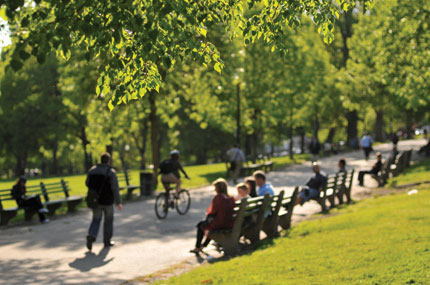Cutting-Edge Research
biology
Saving Face – With Stem Cells
by Matthew Hutson
When cell biologist Louis Terracio started tissue engineering, the prospect of growing facial muscles seemed so far-off that he assumed he’d sooner see pigs fly. But thanks to rapid advances in stem cell science and, this year, a $1 million grant from the New York State Department of Health, Terracio and his team will soon cultivate pig muscles for transplant into a pig’s head and neck. And what they learn from these pigs, they hope, may eventually help to reconstruct the smiles of an increasing number of cancer, war, and accident survivors for whom facial trauma is psychologically and emotionally debilitating. “Craniofacial injuries aren’t usually life-threatening, but they’re tremendously life-altering,” says Terracio, who is the associate dean for research at the College of Dentistry. “You are who you are through your facial expression.” Using certain stem cells,
scientists can now grow
new face muscles.
Using certain stem cells,
scientists can now grow
new face muscles.
Fortunately, the fibers of skeletal muscles—the muscles that move your legs and animate your grin—contain a type of stem cell, called satellite cells, that can develop into new muscle relatively easily. Terracio has already mastered the art of isolating these cells from rats and growing them into patches that can be sutured back into the donor animal. Working with Michael Yost of the University of South Carolina, Terracio applies satellite cells to collagen and places them in a bioreactor where they can multiply and grow. When he first tested the results, he recalls, “Everybody said, ‘My God, it’s beautiful! It acts just like muscle!’ ”
Now he’s turned to a larger animal. Pigs are good models for humans because they share similar physiology, and he’s also planning experiments to see whether nerves will grow into their muscle once it’s transplanted. Other labs in the field are working to speed the sprouting of nerves and blood vessels into new tissue. Terracio hopes that all of these efforts “will coalesce, where a clinician can take the technology we develop and grow new muscle for somebody’s face—or maybe, way down the line, replace much larger muscles.” He’s already seeking NIH funding for human testing.
Terracio is not the only scientist trying to isolate and culture muscle cells, but so far no one else’s protocol has worked. In this, as with fine facial movements, “there’s such nuance,” he says, with a hint of a smile.
medicine
Feeling Good About Fish
by Kevin Fallon / CAS ’09

Is salmon a postsurgery savior? That might be overstating it a bit, but new research suggests that nutritional supplements containing omega-3 fatty acids, commonly found in oily fish such as salmon and mackerel, can have significant benefits for cancer patients recovering from surgery.
The new study found that people undergoing surgery for esophageal cancer (chosen because the procedure is associated with severe loss of muscle mass) are likely to maintain their weight when treated with nutritional supplements containing high doses of the fatty acid. The weight retention in turn improves patients’ quality of life and reduces complications. “They’re able to get up, get dressed, and go to shop,” says Aoife Ryan, an assistant professor of nutrition at the Steinhardt School of Culture, Education, and Human Development, who conducted the study in conjunction with Trinity College Dublin and St. James Hospital.
The findings, published in Annals of Surgery, were based on a double-blind experiment of patients awaiting esophagectomy surgery. Both groups were given a nutritional supplement each day beginning five days before and continuing 21 days after the procedure, but the treatment group received a formula enriched with the omega-3 fatty acid. While the group receiving the standard supplement experienced “clinically severe” weight loss—on average, four pounds of muscle mass—the group treated with omega-3 retained their weight and experienced no negative side effects.
Ryan hopes that the treatment will soon be standard care for major surgeries, including procedures to treat head, neck, colon, and stomach cancer. She notes: “It saves thousands of dollars by getting patients healed faster instead of hanging around in hospitals picking up infections.”
transportation
A Walk in the Figurative Park
by Lindsay Mueller / CAS ’09
 Parks such as Boston Common have amenities that walkers want.
Parks such as Boston Common have amenities that walkers want.
In 2005, the Department of Transportation failed to spend $1.6 billion in its pedestrian planning budget. Why? No one knew what to do with the money, says Zhan Guo, because most research focuses on highways and car congestion. But Guo, an assistant professor of urban planning and transportation policy at the Robert F. Wagner Graduate School of Public Service, hopes to change that by identifying what makes us get out of our cars—or the subway—and walk.
In a recent Boston-based experiment, he quantified how walkers value “amenities” encountered along their path. These could be flowers, retail stores, security, or anything that contributes to a positive experience. Guo compared the actual time it took to walk somewhere to the perceived time and found that most people would rather spend a few extra minutes strolling through bucolic Boston Common, for example, than a narrow side street with fewer trees and less to see.
Guo hopes the research will guide future planning, and eventually help to reduce carbon emissions and tighten Americans’ literal and figurative belts. “Right now, walking is a decoration in the whole transportation program,” he says. “My point is: It’s the foundation.”
politics
No Black and White Answers
by Padraic Wheeler / CAS ’09
Last year, when Californians voted to eliminate same-sex marriage, many pundits rushed to explain Proposition 8’s passage as a clash between race and sexual orientation. The record election turnout among minorities, they supposed, had reversed the tide in one of the more gay-friendly states. The Washington Times declared “Blacks, Hispanics Nixed Gay Marriage,” and similar headlines peppered papers across the country. Some exit polls claimed that 70 percent of black voters had supported the ban.
This was a red flag to Patrick Egan, an assistant professor in the Wilf Family Department of Politics. “It seemed like the exit polls didn’t square with how blacks and Latinos voted in previous referenda about same-sex marriage,” Egan explains. So he, with Kenneth Sherrill of Hunter College, pored over election returns and demographics from precincts where the majority of African-American voters lived. In a paper published by the National Gay and Lesbian Task Force Policy Institute, they report that party identification, age, religiosity, and political view drove voting far more than race, gender, or even having gay or lesbian family and friends. And while 58 percent of African-Americans—compared to 52 percent of all Californians—voted for the measure, the authors conclude that this is the result of greater religiosity among that group.
Now that the California Supreme Court has upheld Prop 8, Egan plans to track how state court decisions, there and elsewhere, have influenced public opinion of same-sex marriage.
Photos from top: © robert price; © istock; © istock







